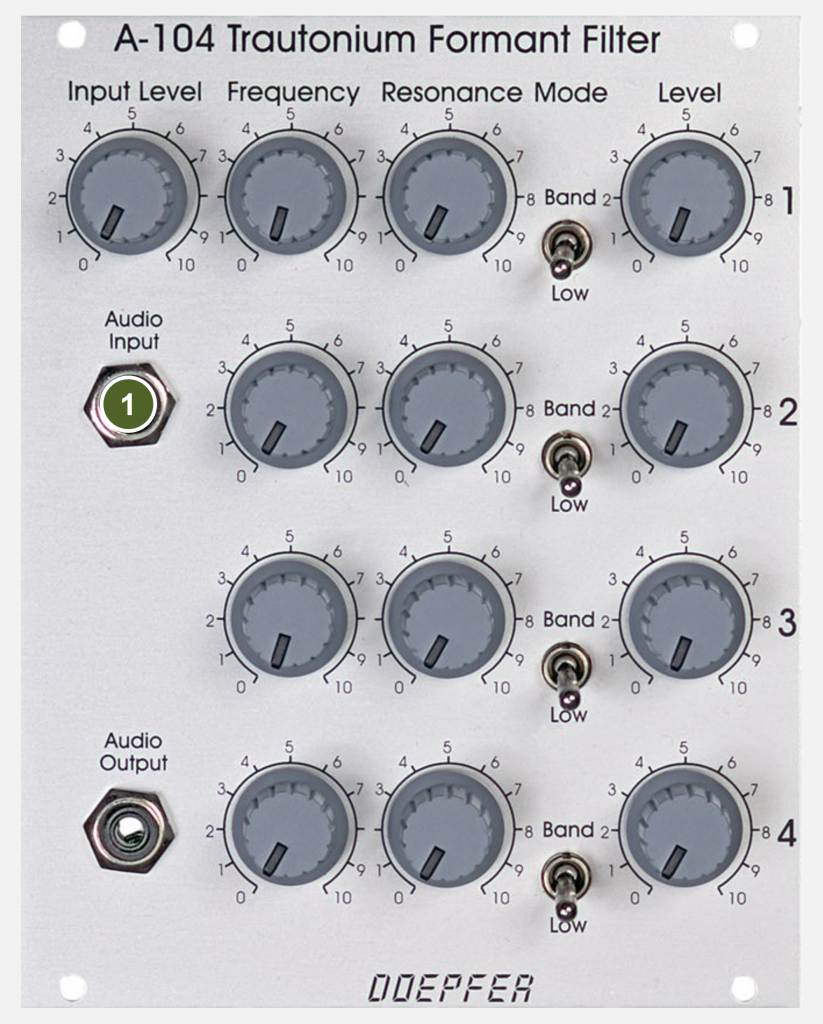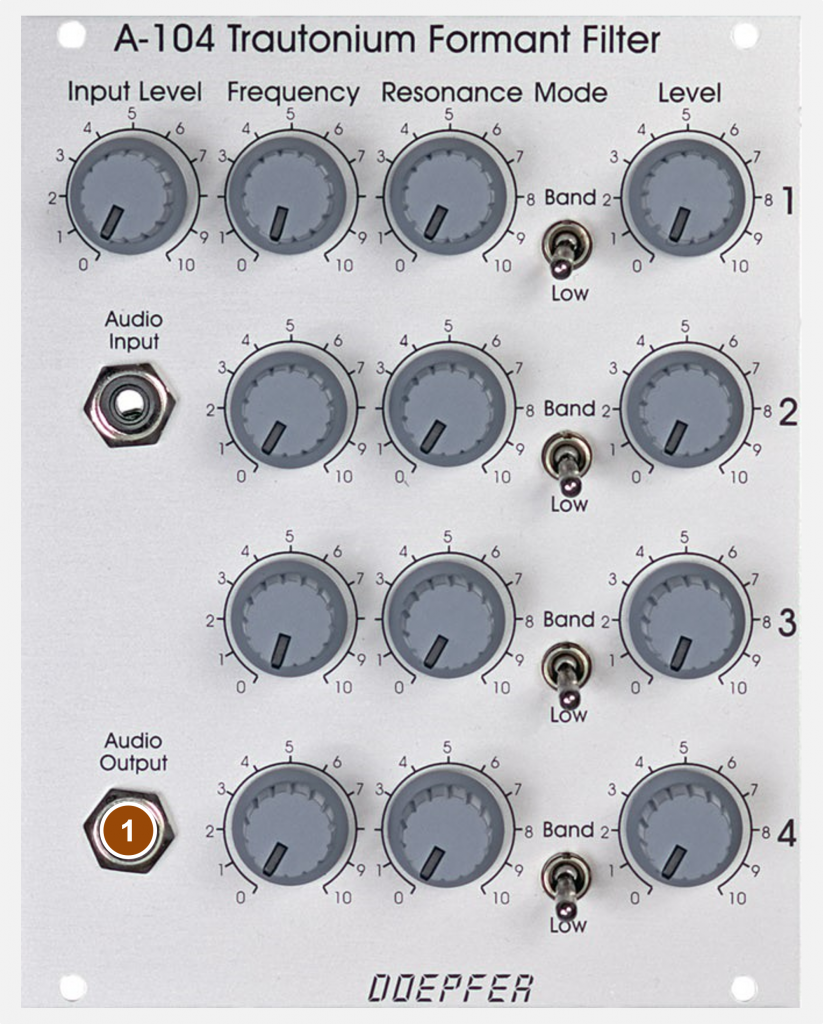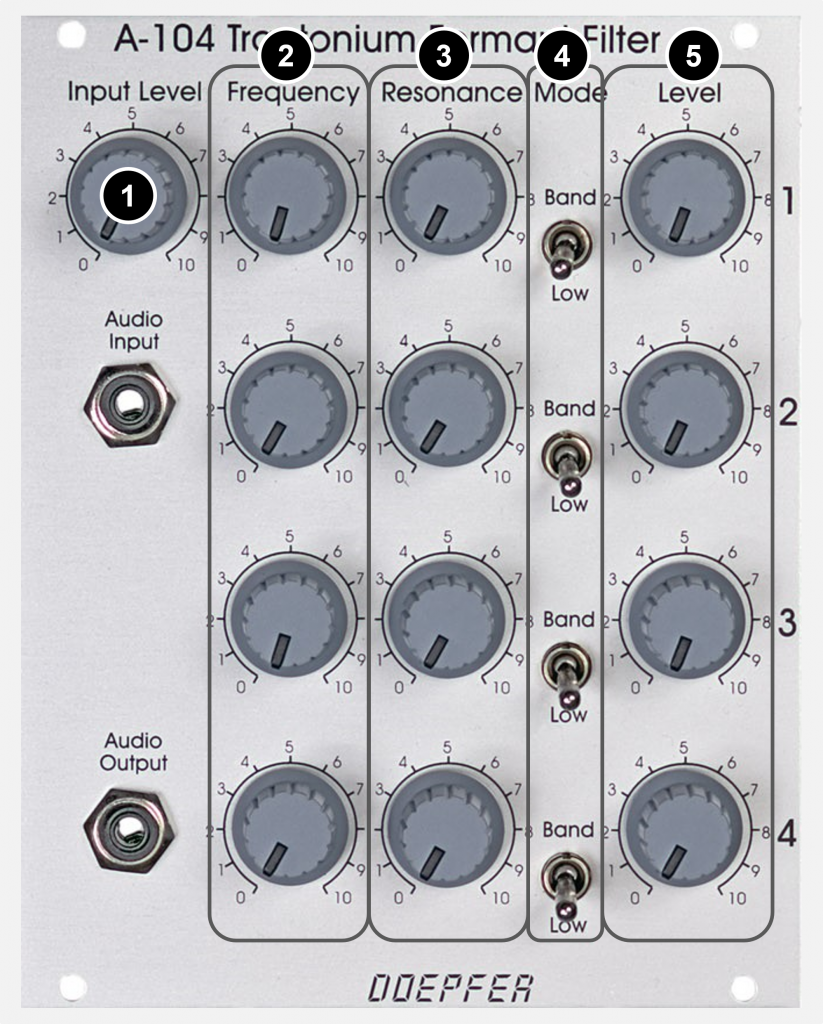The module is inspired by Friedrich Trautwein’s Trautonium, a forerunner of today’s synthesizer. The Trautonium became particularly well-known through the work of Oskar Sala, who used it to produce the film music for Hitchcock’s “The Birds”. However, other composers of the 20th century also composed for the trautonium, such as Paul Hindemith.
In principle, the Trautonium filter consists of 4 filters connected in parallel, each of which can be manually switched between bandpass and lowpass. Speaking of manual: The cutoff-frequencies and the resonances of the filters can also only be operated manually here, there are no inputs for control voltages. This is of course “historically correct”, but still a bit of a pity within an otherwise largely voltage-controllable system. On the other hand, the filter compensates with a sound that, when it reaches saturation, is very “smooth” and very pleasantly goes into an extremely harmonic overdrive.
User interface
Inputs:

- Audio Input: Audio input.
Outputs:

- Audio Output: Audio output for the filtered signal.
Controls:

- Input Level: Attenuator for the audio input.
- Frequency (4 controls): Cutoff-frequencies of the 4 filters.
- Resonance (4 controls): Resonances of the 4 filters.
- Mode (4 switches): Switching between bandpass (“Band”) and lowpass (“Low”) operating modes of the 4 filters. The filter is switched off when the three-stage switch is in the middle position.
- Level (4 controls): Control for mixing the proportions of the 4 parallel-connected filters on the output signal.
A trautonium is recreated
The standard purpose of use of a trautonium filter is – who would have thought it – in a trautonium. Doepfer offers all the components to build a fully functional Trautonium.
Compared to the originals, only the control of the pitch via the manual is not as sensitive. In the original, a metal string is used in a mechanically very complex construction, the possible pressure path is several centimeters. In the context of a budget-friendly (and also maintenance-friendly!) production, something like this is probably not feasible. On the other hand, the Doepfer Trautonium can be wonderfully expanded and modified in a modular way, which of course is not possible with the original.

Used modules
Top row: A-198 (8 HP), A-180-1 (4 HP), A-156 (8 HP), A-162 (8 HP), A-185-2 (6 HP), A-110-1 (10 HP), A-111-1 (14 HP), A-113 (26 HP).
Bottom row: A-177-2 (4 HP), A-143-1 (28 HP), A-118-1 (8 HP), A-138 (8 HP), A-104 (20 HP), A-132-3 (8 HP), A-199 (8 HP).
Alternative: A-127
A possible replacement for the Trautonium filter is the A-127 Triple Resonance Filter: It only has three filters connected in parallel, but has a control voltage input for each filter and a built-in modulation LFO. In the original state, the filter can only be switched between band and low-pass using jumpers on the circuit board, but with the A-127BOM breakout module, all operating modes (plus high-pass and notch!) are available separately for all three filter stages.
Sound examples
-
A-104, A-113, A-198 / Mini Trautonium
Setup: An A-110-1 VCO is controlled by an A-198 Ribbon Controller. The control voltage is quantized with an A-156, but is then smoothed with an A-171-2 VC Slew Generator according to the pressure on the controller (portamento).
The square output of the A-110-1 controls an A-113 subharmonic generator, the predefined presets are controlled by two tracks from an A-157 trigger sequencer. The mix of the triangle output of the A-110-1 and the A-113 is processed with an A-104 Trautonium filter, the filter frequencies are controlled manually.
Finally, the output of the filter is amplified with an A-131 VCA, which is controlled by both the A-198‘s pressure and the envelope of an A-142-1 VC Decay. The A-142-1 is triggered by the A-198‘s pressure.
Plenty of delay and reverb from the DAW at the end.
Trautonium in modern A-100 Setup. -
A-104 / Trautonium filter as a “conventional” filter
Setup: 3 A-110-1 VCOs (sawtooth in octave intervals) are controlled by an arpeggiator, mixed and fed into the A-104 filter. The filter output goes into an A-131 VCA, which is also controlled by the arpeggiator via an A-140 ADSR.
In the absence of voltage control, all changes in the filter are carried out manually. In the first 3 examples, the input level is set to “5”, there is only a small amount of distortion. In the following examples, the input level is set to “10” and shows very nicely the changes in sound caused by the very harmonic overdrive of the filter.
Filter sweep with a single bandpass filter, no resonance, “Input Level” set to 5. Filter sweep with a single lowpass filter, no resonance, “Input Level” set to 5. The 4 filter units are set to different cutoff-frequencies and are unsystematically set to bandpass, lowpass or “off”, “Input Level” to 5. The 4 filter units are all set to bandpass. Cutoff-frequencies and resonance are manipulated unsystematically, “Input Level” on 10. The 4 filter units are all set to lowpass. Cutoff-frequencies and resonance are manipulated unsystematically, “Input Level” on 10. The 4 filter units are all manipulated unsystematically in filter modes (BP/LP), cutoff-frequencies and resonance, “Input Level” on 10.
Technical specifications
| Width | 20 HP |
| Depth | 45 mm |
| Power requirements | 30 mA (+12V) / -10 mA (-12V) |
